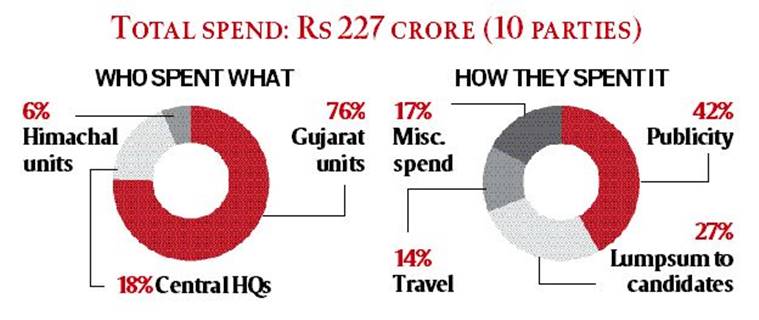LAST MONTH, the Election Commission had called an all-party meeting to discuss the possibility of capping election expenditure by parties. As reported by The Indian Express then, the EC imposes limits on campaign expenditure incurred by a candidate (Rs 50-70 lakh for Lok Sabha and Rs 20-28 lakh for Assembly, both varying state by state) but there is no cap on expenses incurred by political parties. A report by the Association for Democratic Reforms (ADR), released this week, highlights large variations in party spending on elections in the states — Gujarat and Himachal Pradesh in this case — and shows that most of the money goes into publicity.

The ADR report analyses the spending by 10 parties on these two Assembly elections in 2017. Their total spend was Rs 227 crore. Over 3/4ths of this — Rs 173 crore — was spent by the Gujarat units of these parties, while the Himachal Pradesh units spent a little over Rs 12 crore, or 5.5%. The remaining expenses, a little under Rs 42 crore, were borne by the central headquarters of these parties.
Nearly Rs 96 crore, or 42% of the total Rs 227 crore, was spent on publicity. Another Rs 61 crore (about 27%) was given as lumpsum amounts to candidates. The remaining Rs 70 crore was spent on travel and miscellaneous expenses. Across all heads, spending by the Gujarat state units was higher than that by the central headquarters or the Himachal Pradesh units. Of the 10 parties, the BJP spent a little under Rs 166 crore, or 73%. The Congress spent over Rs 50 crore, or 22%. Among the remaining eight parties, the SP spent over Rs 9 crore and the BSP almost Rs 1.30 crore; the other six parties spent less than Rs 1 crore each.

Tip for Reading List: MI5’s secret Nazi hunter
During the Second World War, a former British bank clerk named Eric Roberts tricked his country’s Nazi sympathisers into believing that he was a Gestapo agent, when he was actually working for MI5. Codenamed Jack King, he built a network of 500 Nazi sympathisers, many of whom passed their secrets to him in the belief that they were working for Hitler. This was a largely unknown story until 2014, when secret MI5 files at the National Archives were revealed. Now, author and political journalist Robert Hutton tells the story of this astounding MI5 operation in a new book.
Agent Jack: The True Story of MI5’s Secret Nazi Hunter reveals how this loose network plotted to undermine Britain, and how MI5 tried to neutralise them through the balding Roberts, gifted with an ability for winning people over. “That there were all sorts of inconspicuous but resourceful British natives plotting to bring down (Winston) Churchill’s government is frightening enough; that they might have succeeded in communicating vital secrets to Berlin hardly bears thinking about.”
The Nazi sympathisers were not brought to book at the end of the war; many lived out their lives believing they had served the Nazi cause. “Roberts eventually retired to Canada with his wife and children. For decades his name was unknown to the public. Agent Jack has paid him a belated and honourable due,” notes the review in The Guardian.
This Word Means: Standard project storm
The Central Water Commission has referred to extreme rainfall that occurred over two intense spells last month in Kerala as a “standard project storm”. Called SPS in short, the expression is used to describe the heaviest rainstorm that has occurred in a region as per rainfall records analysed through a hydro-meteorological approach. “We will look at historical rainfall records, for all storms in the region and determine the depth and maximum area that it affected in that period. In other words, an SPS is an storm which has occurred over an an area, with the maximum depth in that area,” CWC Director, Hydrology (South), N N Rai told The Indian Express.
Rai said that the CWC collates what is known as “Probable Maximum Precipitation” for different basins which provides the historical rainfall records. In a report submitted Monday to the Kerala government, the CWC said two-day and three-day rainfall depths in the Pamba, Periyar and Bharathapuzha sub-basins are almost comparable to the the Devikulam storm of July 16-18, 1924. “For the entire Kerala the depth of rainfall realised during 15-17, August 2018 is 414 mm, while the same during 16-18, July 1924 was 443 mm,” the report said.

